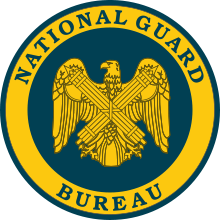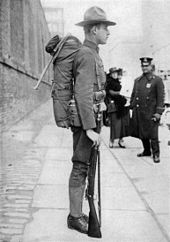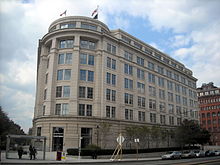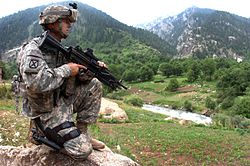- National Guard of the United States
-
For the National Guard of a State and other countries' National Guard, see National Guard (disambiguation). For the American Civil War regiment, see 11th New York Volunteer Infantry Regiment.
National Guard of the United States 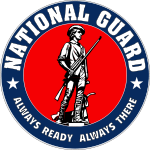
Active 1636-present[1] Country United States Allegiance State (32 U.S.C.)
Federal (10 U.S.C.)Branch United States Army &
United States Air ForceRole Reserve force Size 467,587 end strength (FY2009) Part of National Guard Bureau Garrison/HQ All 50 states, as well as organized territories Nickname Air Guard
Army GuardMotto "Always Ready, Always There" Commanders Current
commanderGeneral Craig R. McKinley,
Chief, National Guard BureauThe National Guard of the United States is a reserve military force composed of state National Guard militia members or units under federally recognized active or inactive armed force service for the United States. Militia members are citizen soldiers, meaning they work part time for the National Guard and hold a civilian job as well.[2][3] The National Guard of the United States is a joint reserve component of the United States Army and the United States Air Force and maintains two subcomponents: the Army National Guard of the United States for the Army[2] and the Air Force's Air National Guard of the United States.[2]
Established under Title 10 and Title 32 of the U.S. Code, state National Guard serves as part of the first-line defense for the United States.[4] The state National Guard is divided into units stationed in each of the 50 states and US territories, and operates under their respective state governor or territorial adjutant general.[5] The National Guard may be called up for active duty by state governors or territorial adjutant general to help respond to domestic emergencies and disasters, such as hurricanes, floods, and earthquakes.[5]
The National Guard of the United States is administered by the National Guard Bureau, which is a joint activity under the Department of Defense.[6][7][8] The National Guard Bureau provides a communication channel for state National Guard to the Department of Defense.[9] The National Guard Bureau also provides policies and requirements for training and funds for training for state Army National Guard and state Air National Guard units,[10] the allocation of federal funds to the Army National Guard of the United States and the Air National Guard of the United States,[10] as well as other administrative responsibilities prescribed under 10 U.S.C. § 10503. The National Guard Bureau is headed by the Chief of the National Guard Bureau (CNGB), who is a four-star general[6][7] in the Army or Air Force.
Contents
Overview
The Militia Act of 1903 organized the various state militias into the present National Guard system. With the passage of the 1916 National Defense Act approximately one half of the United States Army's available combat forces and approximately one third of its support organizations were National Guard units. The Air National Guard part of the United States Air Force was established in 1947.
Title 10 of the US Code states:
(a) The militia of the United States consists of all able-bodied males at least 17 years of age and, except as provided in section 313 of title 32, under 45 years of age who are, or who have made a declaration of intention to become, citizens of the United States and of female citizens of the United States who are members of the National Guard.
(b) The classes of the militia are—- (1) the organized militia, which consists of the National Guard and the Naval Militia; and
- (2) the unorganized militia, which consists of the members of the militia who are not members of the National Guard or the Naval Militia.[11]
Many states also maintain their own State Defense Forces. These forces are federally recognized militia but not as an armed force service. Because of this, they are separate from the National Guard and are not meant to be federalized. They serve the state exclusively, especially when the National Guard is deployed or otherwise unavailable.
Army National Guard units are trained and equipped as part of the U.S. Army. The Army also operated air units until the passage of the 1947 National Defense Act. This created the U.S. Air Force, as well as the separate Air National Guard. Air National Guard units are trained and equipped as part of the U.S. Air Force. Both are expected to adhere to the same moral and physical standards as their "full-time" federal counterparts. The same ranks and insignia are used and National Guardsmen are eligible to receive all United States military awards. The National Guard also bestows a number of state awards for local services rendered in a service member's home state.
Constitutional basis
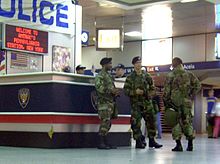 National Guardsmen, Penn Station, New York City
National Guardsmen, Penn Station, New York City
The United States National Guard is authorized by the Constitution of the United States. As originally drafted, the Constitution recognized the existing state Militias, and gave them vital roles to fill: "to execute the Laws of the Union, suppress Insurrections and repel Invasion." (Article I, Section 8, Clause 14). The Constitution distinguished "Militia(s)", which were state entities, from "Troops", which were unlawful for states to maintain under normal circumstances. (Article I, Section 10, Clause 3).
Though originally state entities, the Constitutional "Militia of the Several States" were not entirely independent, however, because they could be federalized. According to Article I, Section 8; Clause 14, the United States Congress is given the power to pass laws for "calling forth the Militia to execute the Laws of the Union, suppress Insurrections and repel Invasions." Congress is also empowered to come up with the guidelines "for organizing, arming, and disciplining, the Militia, and for governing such Part of them as may be employed in the Service of the United States, reserving to the States respectively, the Appointment of the Officers, and the Authority of training the Militia according to the discipline prescribed by Congress" (clause 15). The President of the United States is the commander-in-chief of the state militias "when called into the actual Service of the United States". (Article II, Section 2).
The traditional state militias were redefined and recreated as the "organized militia" – the National Guard, via the Militia Act of 1903. They were now subject to an increasing amount of federal control, including having arms and accouterments supplied by the central government, federal funding, and numerous closer ties to the Regular Army.
Laws covering the National Guard and the National Guard of the United States
The United States Congress has enacted various laws which control the National Guard
- The Militia Act of 1792
- Providing for the authority of the President to call out the Militia, and providing federal standards for the organization of the Militia.
- For the 111 years that the Militia Act of 1792 remained in effect, it defined the position of the militia in relation to the federal government. The War of 1812 tested this uniquely American defense establishment. To fight the War of 1812, the republic formed a small regular military and trained it to protect the frontiers and coastlines. Although it performed poorly in the offensive against Canada, the small force of regulars backed by a well-armed militia, accomplished its defensive mission well. Generals like Andrew Jackson proved that, just as they had in the Revolution, regulars and militia could be effective when employed as a team.
- The Insurrection Act
- The Militia Act of 1862
- Providing for the service of persons of African descent in the Militia, and the emancipation of slaves owned by Confederates.
- Title 18, U.S. Code, Section 1385: The Posse Comitatus Act of 18 June 1878
- Reaction in Congress against the Reconstruction-era suspensions of Southern states' rights to organize militias led to the passage of the Posse Comitatus Act, restricting any person's use of the U.S. Army and, as later amended, the U.S. Air Force in domestic law enforcement (use of the Navy and Marine Corps, being uniformed services within the Department of Defense, is similarly restricted by statute).[12] The U.S. Coast Guard, in its peacetime role within the Department of Homeland Security, and the National Guard, when not in Federal Service, are specifically not limited by this act.
- The States revise the military codes - 1881 to 1892
- The Militia Act of 1903
- Established the creation of the National Guard of the United States as the primary organized reserve force for the U.S. armed forces.
- National Defense Act of 1916
- This act abandoned the idea of an expandable Regular Army and firmly established the traditional concept of the citizens' army as the keystone of the United States defense forces. It established the concept of merging the National Guard, the Army Reserve, and the Regular Army into the Army of the United States in time of war. The act further expanded the National Guard's role, and guaranteed the State militias' status as the Army's primary reserve force. The law mandated use of the term "National Guard" for that force, and the President was given authority, in case of war or national emergency, to mobilize the National Guard for the duration of the emergency. The number of yearly drills increased from 24 to 48 and annual training from five to 15 days. Drill pay was authorized for the first time.
- The National Defense Act Amendments of 1920
- This act established that the chief of the Militia Bureau (later the National Guard Bureau) would be a National Guard officer, that National Guard officers would be assigned to the general staff and that the divisions, as used by the Guard in World War I, would be reorganized.
- The National Guard Mobilization Act, 1933
- Made the National Guard a component of the Army.
- The National Defense Act of 1947
- Section 207 (f) established the Air National Guard of the United States, under the National Guard Bureau.
- The Total Force Policy, 1973
- Requires all active and reserve military organizations be treated as a single force.
- The Montgomery Amendment to the National Defense Authorization Act for Fiscal Year 1987
- provides that a governor cannot withhold consent with regard to active duty outside the United States because of any objection to the location, purpose, type, or schedule of such duty. This law was challenged and upheld by the Supreme Court of the United States in 1990 in Perpich v. Department of Defense.[13])
- The John Warner Defense Authorization Act of 2007 Pub.L. 109-364
- Federal law was changed in section 1076 so that the Governor of a state is no longer the sole commander in chief of their state's National Guard during emergencies within the state. The President of the United States will now be able to take total control of a state's National Guard units without the governor's consent.[14] In a letter to Congress all 50 governors opposed the increase in power of the president over the National Guard.[15]
- The National Defense Authorization Act 2008 Pub.L. 110-181
- Repeals provisions in section 1076 in Pub.L. 109-364 but still enables the President to call up the National Guard of the United States for active federal military service during Congressionally sanctioned national emergency or war. Places the National Guard Bureau directly under the Department of Defense as a joint activity. Promoted the Chief of the National Guard Bureau from a three-star to a four-star general.
Duties and administrative organization
 National Guard Bureau Officer Branch of Service Insignia
National Guard Bureau Officer Branch of Service Insignia
National Guard units can be mobilized for active duty to supplement regular armed forces during times of war or national emergency declared by Congress,[16] the President[16] or the Secretary of Defense.[17] They can also be activated for service in their respective states upon declaration of a state of emergency by the governor of the state or territory in which they serve; in the case of Washington, D.C., the Commanding General. Unlike Army Reserve members, National Guard members cannot be mobilized individually, except through voluntary transfers and Temporary Duty Assignments (TDY). However, there have been a significant number of individual activations to support ongoing military operations related to the Global War on Terrorism (beginning in 2001); the legality of this policy is a major issue within the National Guard.[citation needed]
The National Guard Bureau is in Arlington, Virginia, and is a joint activity of the Department of Defense to conduct all the administrative matters pertaining to the Army National Guard and the Air National Guard. The current chief of the National Guard Bureau is General Craig R. McKinley. The chief is the senior uniformed National Guard officer, in charge of developing all policies and advising the Chairman of the Joint Chiefs of Staff, the Secretaries and Chiefs of Staff of the Army and the Air Force on all National Guard issues. He is appointed by the President in his capacity as Commander in Chief.
History
Early history
The claim that the National Guard is older than the nation itself, with over three and a half centuries of service, is based on the fact that the modern-day 101st Field Artillery Regiment, 182nd Infantry Regiment, 101st Engineer Battalion and 181st Infantry Regiment of the Massachusetts Army National Guard are directly descended from Massachusetts Bay Colony regiments formed over 370 years ago. On 12 December 1648,[18] the General Court of the Massachusetts Bay Colony had ordered that the Colony's scattered militia companies be organized into North, South and East Regiments—with a goal of increasing the militias' accountability to the colonial government, efficacy, and responsiveness in conflicts with indigenous Pequot Indians. Under this act, white males between the ages of 16 and 60 were obligated to possess arms and to play a part in the defense of their communities by serving in nightly guard details and participating in weekly drills. After the United States came into existence, state militias would develop out of this tradition.
The visit of the Marquis de Lafayette to the U.S., in 1824-25, was in every sense a triumphal procession. The 2nd Battalion, 11th New York Artillery, was one of many militia commands who turned out in welcome. This unit decided to adopt the title "National Guard," in honor of Lafayette's celebrated Garde Nationale de Paris. The Battalion, later the 7th Regiment, was prominent in the line of march on the occasion of Lafayette's final passage through New York en route home to France. Taking note of the troops named for his old command, Lafayette alighted from his carriage, walked down the line, clasping each officer by the hand as he passed. "National Guard" was destined to become the name of the U.S. militia.
20th century
Throughout the 19th century the regular Army was small, and the militia provided the majority of the troops during the Mexican-American War, the start of the American Civil War, and the Spanish-American War. In 1903, part of the militia was federalized and renamed the National Guard and organized as a Reserve force for the Army; this is the official founding of the National Guard. In World War I, the National Guard made up 40 percent of the U.S. combat divisions in France. In World War II the National Guard made up 19 divisions. One hundred forty thousand Guardsmen were mobilized during the Korean War and over 63,000 for Operation Desert Storm. They have also participated in U.S. peacekeeping operations in Somalia, Haiti, Saudi Arabia, Kuwait, Bosnia, and Kosovo as well as for natural disasters, strikes, riots and security for the Olympic Games when they have been in the States.
Following World War II, the National Guard aviation units became the Air National Guard. There is no Naval National Guard due to the constitutional provision against states having ships of war in time of peace, though Alaska, California, New Jersey, New York, South Carolina, Texas and Ohio have incorporated Naval Militia units, and the United States Coast Guard has military prerogatives in time of war. At this time the National Guard consisted of 27 Divisions; 25 Infantry and two armored, plus scores of smaller units.
On September 24, 1957 President Dwight D. Eisenhower federalized the entire Arkansas National Guard in order to ensure the safe entry of the Little Rock 9 to Little Rock Central High School the following day. Governor Orval Faubus had previously used members of the guard to deny the students entry to the school.
The New York National Guard were ordered by Governor Nelson A. Rockefeller to respond to the Rochester 1964 race riot in July of that year, the first such use of the Guard in a Northern city. The California Army National Guard were mobilized by the Governor of California Edmund Gerald Brown, Sr. during the Watts Riots, in August 1965, to provide security and help restore order.
Elements of the Ohio Army National Guard were ordered to Kent State University by Ohio's governor Jim Rhodes to quell anti-Vietnam War protests, culminating in their shooting into a crowd of students on 4 May 1970, killing four and injuring nine.
The 2 Battalion 138th Field Artillery of the Kentucky National Guard was ordered to service in Vietnam in late 1968. The unit served in support of the regular 101st Airborne Division. The Battalion's C Battery lost 9 men killed and thirty-two wounded when North Vietnamese troops overran Fire Base Tomahawk on June 19, 1969.[19]
During the LA Riots in 1992, when portions of south central Los Angeles erupted in chaos, overwhelming the Los Angeles Police Department's ability to contain the violence, the California National Guard were mobilized to help restore order. The National Guard were attributed with five shootings of people suspected of violating the curfew order placed on the city.
During the Waco Siege in 1993 the Texas National Guard was called in to assist the Bureau of Alcohol, Tobacco, Firearms and Explosives in bringing down the Branch Davidians, the National Guard's involvement was mostly for defensive purposes. The ATF suspected that the Branch Davidians could be armed with powerful weapons, and so the M1A1 Abrams tanks were used to protect the ATF's retreat area, some National Guard helicopters were also used to do reconnaissance work and an unknown number of National Guard snipers assisted the ATF in the final assault.
As a result of the Bottom Up Review and post Cold War force cutbacks, the Army National Guard maneuver force was reduced to eight divisions (from ten; the 26th Infantry and 50th Armored were consolidated in the northeastern states) and fifteen 'enhanced brigades,' which were supposed to be ready for combat operations, augmenting the active force, within 90 days.[20]
21st century
The National Guard Memorial Building in Washington, D.C.
National Guard units played a major role in providing security and assisting recovery efforts in the aftermath of Hurricane Katrina, in September 2005.
In January and February 2007, National Guard troops from 8 states were activated to go help shovel snow, drop hay for starving cattle, deliver food and necessities to stranded people in their houses, and help control traffic and rescue stranded motorists in blizzards dropping feet of snow across the country.[21]
The Air National Guard has more than 106,000 personnel, and the Army National Guard (ARNG) around 325,000 personnel (as of February 2006).[citation needed]
In 2005, National Guard members and reservists were said to comprise a larger percentage of frontline fighting forces than in any war in U.S. history (about 43 percent in Iraq and 55 percent in Afghanistan).[22] There were more than 183,366 National Guard members and reservists on active duty nationwide who left behind about 300,000 dependents, according to U.S. Defense Department statistics. In 2011, Army Chief of Staff Gen. George W. Casey, Jr. stated that "Every Guard brigade has deployed to Iraq or Afghanistan, and over 300,000 Guardsmen have deployed in this war."[23]
The Army National Guard is reorganizing into 28 brigade combat teams and 78 support brigades as a part of the Army's transformation plan. When the reorganization is complete, brigades will have 3,000-to-4,000 soldiers whereas the former Army organization was principally structured around large, mostly mechanized, divisions of around 15,000 soldiers each.
In the first quarter of 2007, United States Secretary of Defense Robert M. Gates announced changes to the Guard deployment policy aimed at shorter and more predictable deployments for National Guard troops. "Gates said his goal is for Guard members to serve a one-year deployment no more than every five years... Gates is imposing a one-year limit to the length of deployment for National Guard Soldiers, effective immediately.” Prior to this time, Guard troops deployed for a standard one-year deployment to Iraq or Afghanistan would serve for 18 or more months including training and transit time. During the transition to the new policy for all troops in the pipeline, deployed or soon to be deployed, some will face deployments faster than every five years. "The one-to-five year cycle does not include activations for state emergencies."[24]
Developments after September 11, 2001
Prior to the attacks against the United States on September 11, 2001, the National Guard's general policy regarding mobilization was that Guardsmen would be required to serve no more than one year cumulative on active duty (with no more than six months overseas) for each five years of regular drill. Due to strains placed on active duty units following the attacks, the possible mobilization time was increased to 18 months (with no more than one year overseas). Additional strains placed on military units as a result of the invasion of Iraq further increased the amount of time a Guardsman could be mobilized to 24 months. Current Department of Defense policy is that no Guardsman will be involuntarily activated for more than 24 months (cumulative) in one six year enlistment period.[citation needed]
Traditionally, most National Guard personnel serve "One weekend a month, two weeks a year", although personnel in highly operational or high demand units serve far more frequently. Typical examples are pilots, navigators and aircrewmen in active flying assignments, primarily in the Air National Guard and to a lesser extent in the Army National Guard. A significant number also serve in a full-time capacity in roles such as Active Guard and Reserve (AGR) or Air Reserve Technician or Army Reserve Technician (ART).
The "One weekend a month, two weeks a year" slogan has lost most of its relevance since the Iraq War, when nearly 28% of total US forces in Iraq and Afghanistan at the end of 2007 consisted of mobilized personnel of the National Guard and other Reserve components.[25]
Agricultural Development Teams
Prior to 2008, the functions of Agricultural Development Teams were within Provincial Reconstruction Teams of the U.S. Government. Today, ADTs consist of people from the Army Guard and the Air National Guard. Today, ADTs bring “an effective platform for enhanced dialogue, building confidence, sharing interests, and increasing cooperation amongst the disparate peoples and tribes of Afghanistan.”[26] These teams are not only affiliated with the U.S. National Guard, they frequently work across agencies, for example with USAID and the Department of State. ADTs provide education and expertise on the ground, while also providing security and order that is traditionally affiliated with the military. These teams have been essential to the counterinsurgency efforts in Afghanistan as a public diplomacy tool to build relations with the local people in the tribes and provinces of the country.
ADTs provide classroom instruction and teachings to Afghan’s about how to improve their farming practices during non-seasonal growing months, which allows the farmers to use skills in the winter to prepare for farming in the summer and fall. This enhances agricultural production and the Afghan economy as a whole. Agricultural education also improves lines of communication and builds trust between the people, the U.S. government, and the Host Nation. Additionally, through word of mouth in the provinces ideas are spread that inform others about these farming techniques, that may not have had direct interaction with the ADTs. The National Guard ADTs also introduce their U.S. civilian colleagues to the Afghan University personnel, which further strengthens relations and trust in the U.S. efforts in Afghanistan.[27]
ADTs also enhance public diplomacy in Afghanistan by providing security to the local provinces they are working within. This tool has provided the teams with the civilian-military partnership that is needed to conduct public diplomacy and defeat the insurgents in Afghanistan. President Barack Obama said that the U.S. will enhance agricultural development instead of big reconstruction projects to build Afghanistan’s economy, to have an immediate impact on the Afghan people. Today, these projects include “basic gardening practices, to large watershed and irrigation projects. There are also projects that teach bee keeping and livestock production: all of which will have a positive impact on unemployment, hunger, and the ability to sustain future generations.”[26]
More and more Afghan tribal leaders have been requesting additional ADTs, which illustrates how important the use of public diplomacy has been in the efforts to win the trust of the Afghan people. The case study from Nangarhar Province in Afghanistan serves as an excellent example. This province is one of the most stable and secure provinces in Afghanistan. For example, over 100,000 Afghans have returned to province; the province has also been declared poppy-free in 2007 by the UN. Additionally, most districts within the province have all-weather paved roads and it is also one of the most productive agricultural regions in Afghanistan.[26] ADT should further its progress within the provinces of Afghanistan in agricultural education, technical support, and logistics. In order to defeat the insurgency in Afghanistan public diplomacy is an essential force, ADTs allow the U.S. to educate the population of Afghanistan with the hopes of strengthening Afghan trust in the American mission in Afghanistan.
National Guard vs Reserve
Combat Arms
The Army National Guard consists of 28 fully capable brigade combat teams with combat support and combat service support components. The Army Reserve is solely Combat Service Support and Combat Support.
Jurisdiction
The National Guard is directed and primarily funded through its respective state. Federal funding is given however. The Army Reserve is solely funded by the Federal government. It is also, however, restricted by posse comitatus.
Notable members
Presidents who have served as Guardsmen
Militia service was a common trait among presidents of the United States. Eighteen of America's 44 presidents have served in colonial or state militias and two have served in the National Guard since it was established in 1903. Among these, three served in colonial militias (George Washington, Thomas Jefferson and James Madison), 15 served in state militias, one in the Army National Guard (Harry S. Truman) and one (George W. Bush) served in the Air National Guard.[28]
Other notable members
- John R. Bolton, United States Representative to the United Nations[29]
- Ralph Haben, former Speaker of the Florida House of Representatives[30]
- Ken Holtzman, 2-time major league baseball All Star pitcher
- John Allen Muhammad, Spree Killer "Beltway Sniper"[31]
- William Joseph Donovan, Founder of the Office of Strategic Services[32]
- Dan Quayle, 44th Vice President of the United States[33]
- Tom Selleck, Actor Magnum P.I. [34]
- Brock Lesnar, UFC Heavyweight Champion [35]
See also
- State Defense Forces
- Militia
- Air National Guard
- Naval Militia
- Transformation of the Army National Guard
- Minutemen
- Youth Challenge Program
- Awards and decorations of the National Guard
Notes
- ^ http://www.ng.mil/About/default.aspx
- ^ a b c 32 U.S.C. § 101 Definitions (National Guard)
- ^ 10 U.S.C. § 12401 Army and Air National Guard of the United States: status
- ^ 32 U.S.C. § 102 General policy
- ^ a b Military Reserves Federal Call Up Authority
- ^ a b Pub.L. 110-181: National Defense Authorization Act for Fiscal Year 2008
- ^ a b Pub.L. 110-181: National Defense Authorization Act for Fiscal Year 2008 full text
- ^ Sec. 1812. Establishment of National Guard Bureau as Joint Activity of the Department of Defense.
- ^ 10 U.S.C. § 10501 National Guard Bureau
- ^ a b 10 U.S.C. § 10503 Functions of National Guard Bureau: charter from Secretaries of the Army and Air Force
- ^ 10 U.S.C. § 311
- ^ 10 U.S.C. § 375 Restriction on direct participation by military personnel
- ^ FindLaw (27 June 2004). "PERPICH v. DEPARTMENT OF DEFENSE, 496 U.S. 334 (1990)". FindLaw. http://laws.findlaw.com/us/496/334.html. Retrieved 2006-05-13.
- ^ Governors lose in power struggle over National Guard
- ^ National Governors Association
- ^ a b 10 U.S.C. § 12302 Ready Reserve
- ^ 10 U.S.C. § 12301 Reserve components generally
- ^ "Salem declared National Guard's birthplace". Boston Herald (Associated Press). August 20, 2010. http://www.bostonherald.com/news/regional/view.bg?articleid=1275983. Retrieved August 21, 2010.
- ^ Kentucky: National Guard History eMuseum - Summary
- ^ Government Accounting Office, Army National Guard: Enhanced Brigades Readiness Improving But Personnel and Workload Are Problems, June 2000, record accessed at DTIC, May 2009. The fifteen enhanced brigades included the 27th (NY), 29th (HI), 32nd (WI), 41st (OR), 45th (OK), 48th (GA), 53rd (FL), 76th (IN), 81st (WA), 256th (LA), 116th Cavalry Brigade (ID), 155th (MS), 218th (SC), and the 278th Armored Cavalry Regiment (TN).
- ^ FindLaw (14 February 2007)."National Guard to Rescue in 8 States". FindLaw. Retrieved on 14 February 2007.
- ^ http://www.illinois.gov/PressReleases/ShowPressRelease.cfm?RecNum=3783&SubjectID=39
- ^ Salzer, Darron. "Casey: National Guard very different today than 30 years ago". National Guard Bureau. http://www.ng.mil/news/archives/2011/03/030411-Casey.aspx. Retrieved 5 March 2011.
- ^ "Gates Promises Predictable Deployments". GX -- the Guard Experience 4 (3): 22. April 2007
- ^ MSNBC. Health. Mental Health. Most vet suicides among Guard, Reserve troops. New government report raises alarm, calls for long-term mental services. Associated Press. February 12, 2008.
- ^ a b c Turner, Colonel Randal L.. "Agricultural Development Teams and the Counterinsurgency Effort in Afghanistan". Strategy Research Project. U.S. Army War College. http://www.dtic.mil/cgi-bin/GetTRDoc?Location=U2&doc=GetTRDoc.pdf&AD=ADA521790. Retrieved April 14, 2011.
- ^ McKinley, General Craig R.. "The National Guard: A Great Value for America". National Guard Bureau. http://www.ng.mil/Images1/docs/Value_of_the_National_Guard.pdf. Retrieved April 15, 2011.
- ^ The National Guard - Image Gallery - Presidential Series
- ^ http://www.mahalo.com/john-bolton
- ^ "Representative Ralph H. Haben, Jr. Speaker (1980 - 1982)". Representatives. Tallahassee, Florida: Florida House of Representatives. 2010. http://www.myfloridahouse.gov/Sections/Representatives/details.aspx?MemberId=2838&SessionId=48. Retrieved 3 September 2010.
- ^ http://www.biography.com/articles/John-Allen-Muhammad-236029
- ^ https://www.cia.gov/news-information/featured-story-archive/gen.-william-j.-donovan-heads-oss.html
- ^ http://www.encyclopedia.com/doc/1G1-6602224.html
- ^ http://www.imdb.com/name/nm0000633/bio
- ^ http://findarticles.com/p/articles/mi_m0KFY/is_12_21/ai_112350861/pg_2/?tag=content;col1
External links
- The Army National Guard Recruiting Site
- The National Guard Bureau
- The National Guard Bureau Heritage Collection
- Virtual Armory (login not required)
Leadership Secretary of the Army · Under Secretary of the Army · Chief of Staff · Vice Chief of Staff · 4-star generals · Sergeant Major of the Army · House Armed Services Committee (House Subcommittee on Air and Land Forces) · Senate Committee on Armed Services (Senate Subcommittee on Air and Land Forces)

Components and
commandsArmy CommandsService ComponentsForces · Africa · Central · Europe · Pacific · North · South · Special Operations · Surface Deployment and Distribution · Space and Missile Defense
Direct Reporting UnitsNetwork Enterprise Technology · Medical · Intelligence and Security · Criminal Investigation · Corps of Engineers · Military District of Washington · Test and Evaluation Command · Military Academy · Reserve · Acquistion Support Center · Installation Management
Field ArmiesBranchesAcquistion Corps · Adjutant General's Corps · Air Defense Artillery Branch · Armor Branch · Aviation Branch · Army Band · Chaplain Corps · Chemical Corps · Civil Affairs Corps · Corps of Engineers · Dental Corps · Field Artillery Corps · Finance Corps · Infantry Branch · Inspector General's Corps · Judge Advocate General's Corps · Logistics Branch · Medical Corps · Medical Service Corps · Medical Specialist Corps · Military Intelligence Corps · Military Police Corps · Nurse Corps · Ordnance Corps · Psychological Operations Corps · Quartermaster Corps · Signal Corps · Special Forces · Transportation Corps · Veterinary Corps
Installations Training Uniforms and insignia Equipment History and traditions History · Continental Army · National Army · Army of the United States · United States Army Air Forces · Center of Military History · Institute of Heraldry · America's Army · Army Art Program · Army Band · Old Guard Fife and Drum Corps · Flag · National Museum · Rangers · Soldier's Creed · The Army Goes Rolling Along · Draft · Service numbersLeadership Secretary of the Air Force · Under Secretary of the Air Force · Chief of Staff · Vice Chief of Staff · Chief Master Sergeant of the Air Force · 4-star generals · House Armed Services Committee (House Subcommittee on Air and Land Forces) · Senate Committee on Armed Services (Senate Subcommittee on Air and Land Forces)

Organization CommandsAir Combat · Air Education and Training · Air Mobility · Global Strike · Materiel · Reserve · Space · Special Operations · Europe · Pacific
First · Second · Third · Fourth · Fifth · Seventh · Eighth · Ninth · Tenth · Eleventh · Twelfth · Thirteenth · Fourteenth · Seventeenth · Eighteenth · Nineteenth · Twentieth · Twenty-Second · Twenty-Third · Twenty-Fourth
Personnel and
trainingAirmen · Rank: Officers / Enlisted · Specialty Code · Aeronautical ratings · Judge Advocate General's Corps · RED HORSE · Office of Special Investigations · Security Forces · Medical Service · Pararescue · Combat Control · Chief of Chaplains · Chief Scientist
Training: USAF Academy · Officer Training School · Reserve Officer Training Corps · Basic Training · Airman Leadership School · SERE · Fitness TestUniforms and
equipmentHistory and
traditionsHistory · Army Air Service / Corps / Forces · "The U.S. Air Force" · Air Force Band · The Airmen of Note · Tops In Blue · Airman's Creed · Core Values · Flag · Symbol · Memorial · National Museum · Air Force One · Honor Guard · Thunderbirds · Service numbersLeadership Commander-in-chief: President of the United States · Secretary of Defense · Deputy Secretary of Defense · Joint Chiefs of Staff (Chairman) · United States Congress: Committees on Armed Services: (Senate · House) · Active duty four-star officers · Highest ranking officers in history · National Security Act of 1947 · Goldwater–Nichols Act
Organization BranchesReserve componentsNorthern · Central · European · Pacific · Southern · Africa · Special Operations · Strategic · Transportation
Structure United States Code (Title 10 · Title 14 · Title 32) · The Pentagon · Installations (A · MC · N · AF · CG) · Budget · Units: (A · MC · N · AF · CG) · Logistics · Media
Operations and history Current deployments · Conflicts · Wars · Timeline · History: (A · MC · N · AF · CG) · Colonial · WWII · Civil affairs · African Americans · Asian Americans · Jewish Americans · Sikh Americans · Historiography: (A: 1/2 · MC · N · AF) · Art: (A · AF)
Personnel TrainingOtherOath: (Enlistment · Office) · Creeds & Codes: (Code of Conduct · NCO · A · MC · N · AF · CG) · Service numbers: (A · MC · N · AF · CG) · Military Occupational Specialty/Rating/Air Force Specialty Code · Pay · Uniform Code of Military Justice · Judge Advocate General's Corps · Military Health System/TRICARE · Separation · Veterans Affairs · Conscription · Chiefs of Chaplains: (A · MC · N · AF · CG)
Equipment LandSeaAirAircraft (WWI · active) · Aircraft designation · Missiles · Helicopter arms
OtherLegend: A = Army, MC = Marine Corps, N = Navy, AF = Air Force, CG = Coast Guard, PHS = Public Health Service, NOAA = National Oceanic and Atmospheric Administration, MSC = Military Sealift CommandCategories:- United States National Guard
- United States Army National Guard
- United States Air National Guard
- Military units and formations established in 1903
- 1903 establishments in the United States
Wikimedia Foundation. 2010.



